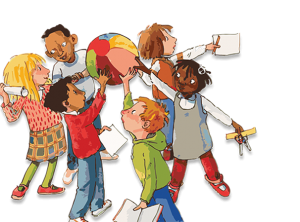Donna Thomson, March 2013 (article for National Primary Head’s Association ‘The Primary Voice’ magazine)
Although heartening to know that we have made improvements in literacy, (Ofsted’s: ‘Moving English Forward’ Report 2012), it was also dispiriting to hear that yet again, ‘..standards in English aren’t high enough and one in five children is not achieving the expected literacy levels by the end of primary school’. For the last decade underachievement in literacy, particularly amongst disadvantaged children in the UK, has stubbornly persisted. The progress in International reading Literacy Study (PIRLS report, 2011), stated that this decline was particularly evident from 2001- 2006 when England dropped from 3rd to 19th place out of 35 countries with regard to reading comprehension. Although children’s comprehension performance in 2011 was significantly higher than in 2006, ‘retrieving straight forward information and inferencing’ was still lower than expected. This prompts the question: ‘Are our literacy levels still below expectations because government initiatives and interventions have not focused on solving the reading comprehension issues reflected in the PIRLS report?’ The Think2read team and a number of other educators believe that this may be so. As far back as 2003, literacy experts such as Morag Stuart (Fine Tuning the NLS, 2003) have warned that ‘we neglect the development of language comprehension at our peril’ and that ‘we need more focused teaching of comprehension strategies’. The 2012 Moving English Forwards report echoes Stuart’s concerns that ‘too few schools currently develop reading skills effectively across the curriculum’. The report also highlights how this impacts on other areas of learning when ‘teachers are less aware of approaches that might help pupils to read effectively and make sense of what they are reading’. For some years now central government directives seemed to have focused almost exclusively on how phonics is taught in primary schools, rather than how we might deliver a more balanced reading experience to children -that includes early comprehension instruction. Particularly effective instructional approaches for comprehension have been those based on reciprocal teaching (Rosenshine and Meister review of Educational research, 1994) in which teaching of more than one comprehension strategy was followed by reading a text and students questioning each other or making predictions about the text (palicsar and Brown,1984). reading instruction that includes explicit teaching of inference skills and questioning(Parkin, Parkin and Pool, New Zealand, 1999) further helps to deepen children’s understanding of how to generate and answer questions about text to extend independent reading for meaning. Inspired by this approach, the Think to read Comprehension Skills project was setup to explore how these reading skills might be assessed and put effectively into practice in classrooms in the UK.
We began this action-research project in our large Devon primary school when we first detected reading comprehension problems amongst our Years 5 & 6 children in 2001. Previously, we had been confident that because many of our children were achieving high fluency levels, they were ‘good readers’. However, when we introduced our readers to reciprocal reading to extend their reading and encourage independent and collaborative exploration of text; to our dismay, our fluent readers struggled to engage with any real confidence in the process. we began to wonder if the long-held assumption that ‘children develop an understanding of text as they become more fluent’ was perilously misplaced. We examined our children’s comprehension skills in greater depth to see if we could uncover the problem and find a possible solution. The results of the investigation were unsettling, to say the least. We extended our assessment and analysis of reading across both key stages over a period of two years from 2001 – 2003 and compared the outcomes from two reading measures: ‘PM Benchmark, Kit 1’(Nelson Thornes, 2000) and the ‘Probe Comprehension reading Assessment’ (Triune Initiatives, New Zealand, 1999). The evidence consistently revealed a discrepancy between the children’s ability to decode and their comprehension at the same level. This was later reflected in the Rose Review’s ‘Simple view of reading’ (2006) and more recently substantiated by York University’s 2008 reading Comprehension study (Snowling, Cain, Nation and Oakhill) that raises the concern that ‘pupils ease at reading words out loud may mask those who have difficulties with comprehension’. The results confirmed to us that teaching for fluency levels and word recognition without including strategic comprehension instruction over time, had produced a significant number of high decoders who had little understanding of the text they were reading or how to delve deeply for meaning to support their understanding. Our assessment analysis identified the following areas of comprehension failure that correlated with Stuart’s findings at the time (Fine Tuning the NLS, 2003):
- poor skimming and scanning skills and tendency to rely on memory only to respond to questions from the text,
- poor knowledge of story structure and the different ways of gathering literal, inference and evaluation information from the text,
- little understanding that the authors intention is presented as clues in the text,
- failure to make links and connections from own experience with that of incoming new knowledge,
- more literal than in-depth enquiry during reading,
- poor interpretation skills due to limited knowledge of vocabulary and grammar.
Our evidence was corroborated later by two local authorities in 2006 (Devon Education Services, and Blaenau-Gwent Education Authority, Wales) who used our assessment procedure to assess reading comprehension skills in greater depth in a number of other schools. The results were similar. The assessment indicated that many of the children’s poor comprehension was due to a lack of strategic knowledge about the skills involved in drawing inferences and making meaning of text. Anne Kispal’s 2008 review, ‘Effective Teaching of Inference Skills for Reading’ echoes this, when she reports that ’Evidence shows that poor inferencing skills cause poor comprehension and not vice versa.’ we concluded that our reading practice needed to change. We needed to rethink our approach to teaching reading skills. whilst acknowledging the importance and success of phonics. We felt that our children also needed to systematically learn how to infer, question and process their thinking as early as possible if they were to achieve a good grasp of the author’s meaning and intention as they read. However, because we could find little in the way of an explicit meta-cognitive and cooperative learning approach to help us teach these skills, we developed our own comprehension and questioning skills programme (Think To Read, 2005 – 2011) based on Palicsar and Brown’s reciprocal reading model (1986), the dialogic approach of philosophy for Children (Murris & Haynes, 2000) and the Taxonomy of Question Types (Parkin, Parkin & Pool, 2002). This was designed initially to provide in-depth comprehension instruction and assessment for our Year 5 and 6 children and later (with modifications) for our children in Year 2 classes upwards. The results from the programme were encouraging. SATS results for the participating Year 6 class during the action-research project showed a particularly high comprehension result of 90% passes at level 4/5, with a significant rise in standards in just two terms. During the trialling and evaluation of the Think2read programme from 2007–2012 we tracked the reading and learning progression of classes as they moved from Year 2 to Year 5. Their reading and comprehension SATs results remained at a high level. Teachers across the school and in two other schools who were using the Think2read methods (2007 – 2008), reported that pupil’s reading improved and ‘the children were more willing to learn from one another’s assumptions and keen to explore and challenge each other about text and the author’s intention’. Maureen Lewis, an observer from the national Literacy Strategy who came to visit the school in 2005, reported that the sessions seemed to have ‘opened the gates to children’s learning of prediction, clarification, questioning and summarising. ’Think2read’s explicit and inclusive approach is particularly effective because it tackles the comprehension problem for children head on. Instead of relying on teachers questions and prompts about text, children as young as six years old are taught how to identify the skills that help them to summarise, predict and clarify text. They also learn how to classify information and consciously generate and answer their own literal, inference and evaluative questions about text. This process enables them to monitor their own understanding with confidence as they read. The importance of child-led rather than teacher-led questioning with regard to comprehension improvement was underlined by Lori Oczkus (National Reading Association, 2005 (citing Singer & Dolan, 1982): ‘when students pose their own questions, they show more improvement in comprehension, than students who simply answer the teacher’s questions.’ The final report of the rose review (2006) acknowledges the importance of reading comprehension within the learning-to-read process: ‘…it is an obvious truth that the goal of reading is comprehension and that skilled reading involves understanding as well as decoding text. In short, learning to read progresses to reading effortlessly to learn. The teaching of beginner readers requires an understanding of the processes that underpin this progression’. The Qualifications and Curriculum Authority (QCA, 2006) emphasised further that pupils need to understand the purpose for reading beyond fluency: ‘Children need to understand that alongside ‘accurate decoding of text, reading involves making meaning from content, structure and language’. Evaluation of Think2Read’s impact on the children’s reading and learning across the school confirmed that youngsters from six years upwards respond well to explicit and dialogic instruction about reading concepts and skills (Real Ideas Organisation, 3 -Year Enquiry project in association with Creative Partnerships 2008 -11). Teachers, pupils and creative practitioners agreed that when the children were shown how to identify the difference between being literal and inferential and how to apply detective skills and questioning to seek meaning for themselves, they gained a greater love of reading and were more able to explore texts independently in reciprocal reading teams. We discovered that the logical progressive steps used to explain these strategies also enabled the children across the age and ability range to make important links of learning to other areas of the curriculum. This led us to wonder whether a general lack of in-depth comprehension instruction and child-led enquiry over the past years might have also impacted on pupil’s motivation and ability to learn in general. In December 2004, the Sunday Times reported that ‘100,000 young people were estimated to leave UK schools each year without basic literacy oral, social and thinking skills to function adequately in society’, (Mckay and Cowling, 2004). One can’t help wondering whether a link exists between the lack of explicit reading comprehension instruction and poor reading for meaning in other learning areas mentioned in the recent Ofsted report (2012) and the McKay and Cowling report that highlights students’ inability to make learning links and connections across the primary and secondary curriculum. During our ten years of the Think2read project we have discovered that there is a way of closing the gap in literacy underachievement that promises to impact not only on reading but also on learning in general. We have learned that when young children understand how to process their thinking to comprehend and question – when they are given the team skills (Johnson, Johnson,and holubec, 1993; Slavin 1991, Stahl and Van Sickle, 1992), and the opportunity to develop a passion for group reading and enquiry – it produces confident and active readers who become independent and collaborative learners.
Where do you stand on phonics only?
Donna Thomson, N0v. 2013, (article for ‘Education for Everybody magazine)
Primary literacy specialist, Donna Thomson, has spoken out, against the practice of teaching young children only synthetic phonics.
She believes there is a “narrow-minded and bullish obsession with synthetic phonics, which is proving harmful to our children’s futures.”
The method has been used in England for nearly 10 years and is often described as a “back to basics” system. It first teaches children the sounds of letters and how they blend into words, before moving to combinations that make up words.
Donna Thomson said: “Successive governments have made synthetic phonics the lynchpin of their efforts to improve literacy, but too many children are reading without understanding; they simply learn to ‘de-code’ the words.”
Her views come hot on the heels of a report by the OECD (Organisation for Economic Co-operation and Development) which placed England near the bottom of an international literacy tests league.
The OECD study showed England had slipped to 22 out of a total of 24 countries.
“If we want our children’s literacy to improve and for reading to become a pleasure, we need to give them the skills that support ‘a whole reading’ experience from the start,” says Ms Thomson, a researcher, primary educational writer and reading comprehension specialist with 15 years’ experience of supporting and extending children with reading and writing difficulties.
She says teaching children how to make meaning gives them the tools to question, understand and make sense of words, images and concepts within context as well as make links to problem solve and understand others’ points of view. It also allows them to develop curiosity, to reason, justify and express themselves clearly.
“All of these skills are the sorts of soft skills that employers are crying out for, yet we are not even furnishing our youngest children with them – we are giving them a shameful diet of synthetic phonics that does not produce the independent readers, and cross-curricular learners we are led to believe it does,” adds Ms Thomson.
In a bid to redress the balance, she is now working with individual headteachers in England and Wales who also think ‘phonics is not enough’.
Wales for instance, has developed a new literacy framework – after the Education and Skills department recognised the need to tackle the teaching of comprehension and cross-curricular literacy head-on.
A recent pilot project with very young children in Wales has been a resounding success, Headteacher at Coed-y-Lan school, Robert James said: “This Think2Read project fulfils most of the skills of the new curriculum in Wales because it asks children to summarise, predict, evaluate and make connections when they read text – in other words to understand, and enjoy, what they are reading.”
Interestingly of the parents who responded to a questionnaire about the Coed-y-lan pilot 94.6 per cent thought their child was beginning to ask more questions when reading a book and the same number reckoned their child was more interested in books.
Ms Thomson said: “‘When you see how empowering it is for six- year-olds to ask and answer their own in-depth questions about text and pictures as they read to support their understanding, it makes you realise just what could be achieved if you begin the reading journey for them at an earlier age through ‘talk’ and discussion about books at school and at home with their parents.”
Next year Ms Thomson will be working with primary schools in South Yorkshire – in an area of high social deprivation, with generations of jobless.
She explained: “The project in Yorkshire is unique. While working with young children (four and five-year-olds) we will also be focusing on parents. Many of these parents will have never been employed and come from a long line of poor education and unemployment. By learning the skills that develop and support their children’s reading and learning – the process will unlock their own potential and provide them with aspirations for further learning alongside their children’s experience. It will also foster important relationships between the community and the school.”
The Yorkshire project is in line with a report last week, which said millions of children in England, and Wales were being held back by their parents’ poor basic skills.
The National Institute of Adult Continuing Education – NIACE – report said involving the whole family in learning can boost educational attainment across generations and should be integral to schools.
Governments, it said, should give family learning more support.
It’s a sentiment echoed by Ms Thomson. “If we want a nation of literate young people we need to start teaching four and five-year- olds how to use strategies for making meaning and asking and answering their own questions about information at home and in school.
“Changing the way that we teach children reading and literacy in their formative years will have a profound and positive effect on our children’s futures for generations to come, I don’t think I can overestimate the effect this could have on our economy in years to come.”


